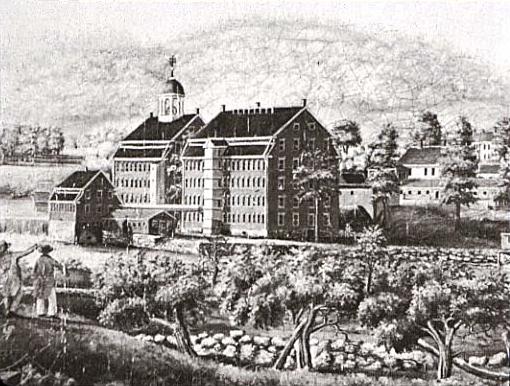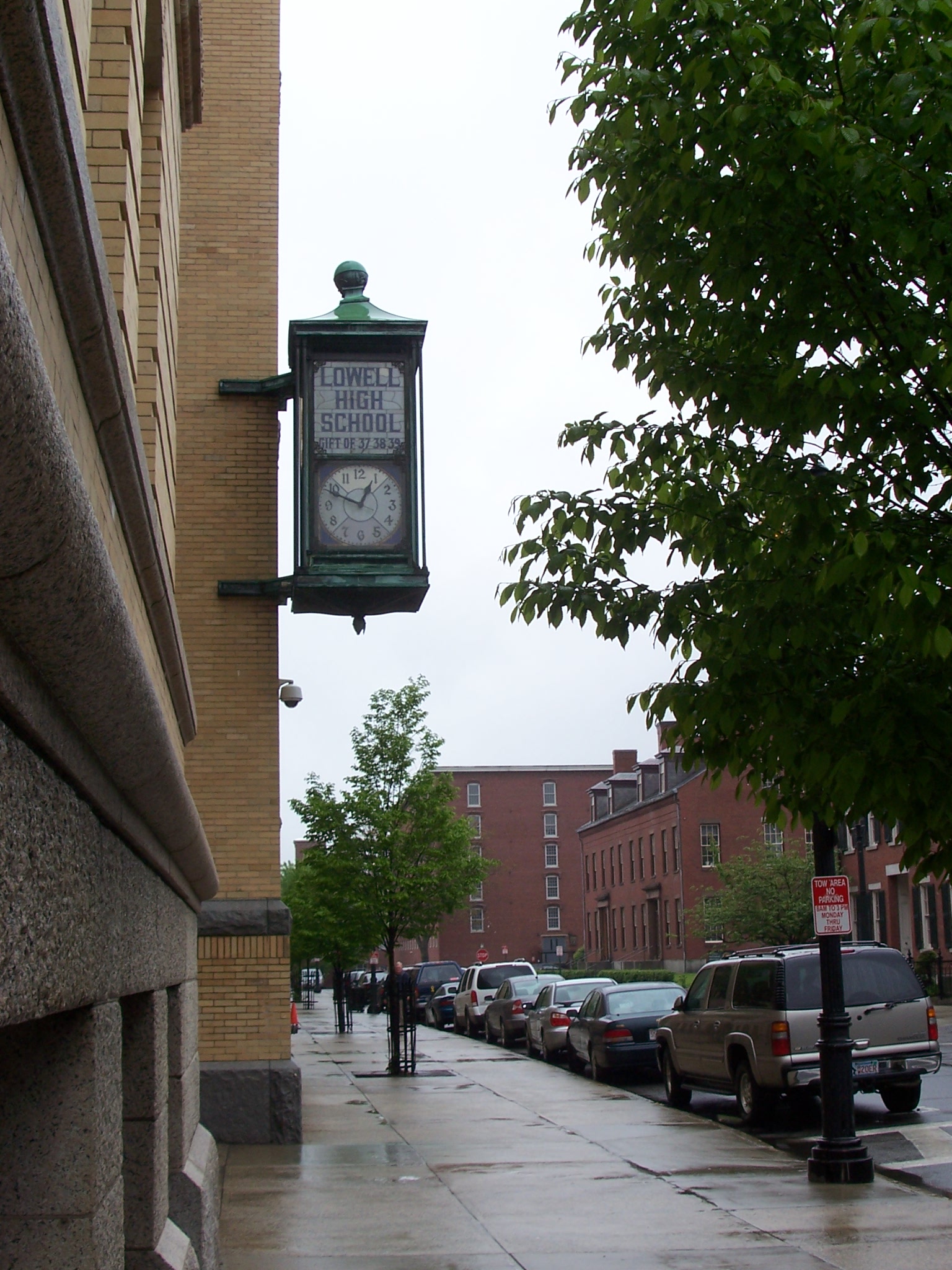|
Merrimack Manufacturing Company
The Merrimack Manufacturing Company (also known as Merrimack Mills) was the first of the major textile manufacturing concerns to open in Lowell, Massachusetts, beginning operations in 1823. History After the death of Francis Cabot Lowell of the Boston Manufacturing Company, his associates (commonly referred to as the Boston Associates) began planning a larger operation in East Chelmsford, Massachusetts, along the Merrimack River. The Merrimack Manufacturing Company, modeled after the second Boston Manufacturing Company mill, was built concurrently with the necessary canals, machine shop, dyehouse, and boardinghouses for the operatives. The system of operation the company employed became known as the Lowell System. Initially capitalized with $600,000, its typical product was calico cloth. Situated at the foot of the Merrimack Canal, the original mills received the full 32' drop of the river. Closely associated with the Proprietors of Locks and Canals and at one point, ... [...More Info...] [...Related Items...] OR: [Wikipedia] [Google] [Baidu] |
Merrimack Mills 1850
Merrimack may refer to: * Merrimack, New Hampshire, a town * Merrimack County, New Hampshire * Merrimack River, in Massachusetts and New Hampshire * Merrimack Valley, the region surrounding the river * Merrimac, California, also spelled Merrimack Education * Merrimack College, North Andover, Massachusetts * Merrimack High School, Merrimack, New Hampshire * Merrimack Valley High School, Penacook, New Hampshire Other uses * Merrimack Pharmaceuticals, a pharmaceutical company based in Massachusetts * USS Merrimack, USS ''Merrimack'', several ships See also * Merrimac (other) * Meramec (other) * Maramec {{disambig, geo fr:Merrimac ... [...More Info...] [...Related Items...] OR: [Wikipedia] [Google] [Baidu] |
Lowell System
The Waltham-Lowell system was a labor and production model employed during the rise of the textile industry in the United States, particularly in New England, amid the larger backdrop of rapid expansion of the Industrial Revolution in the early 19th century. Made possible by inventions such as the spinning jenny, spinning mule, and water frame around the time of the American Revolution, the textile industry was among the earliest mechanized industries, and models of production and labor sources were first explored here. The system used domestic labor, often referred to as mill girls, who came to the new textile centers from rural towns to earn more money than they could at home, and to live a cultured life in "the city." Their life was very regimented—they lived in the company boardinghouses and were held to strict hours and a moral code. As competition grew in the domestic textile industry and wages declined, strikes began to occur, and with the introduction of cheaper impo ... [...More Info...] [...Related Items...] OR: [Wikipedia] [Google] [Baidu] |
Lowell High School (Lowell, Massachusetts)
Lowell High School is a single-campus public high school located in downtown Lowell, Massachusetts, United States. The school is a part of Lowell Public Schools. The mascot is the Red Raider and the colors are maroon & gray. Current enrollment is over 3,000 students. History Lowell, Massachusetts was incorporated as a town in 1826 and Lowell High School opened shortly after in 1831. One of its earliest homes was a small brick building on Middlesex Street owned by the Hamilton Manufacturing Company. Lowell High School was the first and remains the oldest desegregated public high school in the United States; African American Caroline Van Vronker was a student at Lowell High School in 1843, at a time when every other public high school in the United States was segregated. In 1840, the high school moved into a new building located between Kirk Street and Anne Street along the Merrimack Canal. Over the next 100 years, the school campus expanded. The oldest extant building replaced ... [...More Info...] [...Related Items...] OR: [Wikipedia] [Google] [Baidu] |
Urban Renewal
Urban renewal (also called urban regeneration in the United Kingdom and urban redevelopment in the United States) is a program of land redevelopment often used to address urban decay in cities. Urban renewal involves the clearing out of blighted areas in inner cities to slum clearance, clear out slums and create opportunities for higher class housing, businesses, and other developments. A primary purpose of urban renewal is to restore economic viability to a given area by attracting external private and public investment and by encouraging business start-ups and survival. It is controversial for its eventual Forced displacement, displacement and Destabilisation, destabilization of low-income residents, including African Americans and other marginalized groups. Historical origins Modern attempts at renewal began in the late 19th century in developed nations, and experienced an intense phase in the late 1940s under the rubric of Reconstruction (architecture), reconstruction. The ... [...More Info...] [...Related Items...] OR: [Wikipedia] [Google] [Baidu] |
Great Depression
The Great Depression (19291939) was an economic shock that impacted most countries across the world. It was a period of economic depression that became evident after a major fall in stock prices in the United States. The economic contagion began around September and led to the Wall Street stock market crash of October 24 (Black Thursday). It was the longest, deepest, and most widespread depression of the 20th century. Between 1929 and 1932, worldwide gross domestic product (GDP) fell by an estimated 15%. By comparison, worldwide GDP fell by less than 1% from 2008 to 2009 during the Great Recession. Some economies started to recover by the mid-1930s. However, in many countries, the negative effects of the Great Depression lasted until the beginning of World War II. Devastating effects were seen in both rich and poor countries with falling personal income, prices, tax revenues, and profits. International trade fell by more than 50%, unemployment in the U.S. rose to 23% and ... [...More Info...] [...Related Items...] OR: [Wikipedia] [Google] [Baidu] |
New England
New England is a region comprising six states in the Northeastern United States: Connecticut, Maine, Massachusetts, New Hampshire, Rhode Island, and Vermont. It is bordered by the state of New York to the west and by the Canadian provinces of New Brunswick to the northeast and Quebec to the north. The Atlantic Ocean is to the east and southeast, and Long Island Sound is to the southwest. Boston is New England's largest city, as well as the capital of Massachusetts. Greater Boston is the largest metropolitan area, with nearly a third of New England's population; this area includes Worcester, Massachusetts (the second-largest city in New England), Manchester, New Hampshire (the largest city in New Hampshire), and Providence, Rhode Island (the capital of and largest city in Rhode Island). In 1620, the Pilgrims, Puritan Separatists from England, established Plymouth Colony, the second successful English settlement in America, following the Jamestown Settlement in Virginia foun ... [...More Info...] [...Related Items...] OR: [Wikipedia] [Google] [Baidu] |
Kirk Boott
Kirk Boott (October 20, 1790 – April 11, 1837) was an American Industrialist instrumental in the early history of Lowell, Massachusetts. Biography Boott was born in Boston, Massachusetts in 1790. His father had emigrated to the United States from England in 1783, and worked in Boston as a wholesale merchant. After studying for a time in Boston schools, the son attended Rugby School in England, and later went to Harvard College (class of 1809). Before graduation, Boott left Harvard for England to study civil engineering with the goal of joining the British army. When he was 21, a commission as lieutenant in the British army was purchased for him. With his regiment, the 85th light infantry, he took part in the peninsular campaign against Napoleon, landing in Spain in August 1813. After Napoleon had been sent to Elba, Boott's regiment was detailed for service against the United States, and took part in the attacks on Washington and on New Orleans. Boott, however, was excused ... [...More Info...] [...Related Items...] OR: [Wikipedia] [Google] [Baidu] |
Proprietors Of Locks And Canals
The Proprietors of Locks and Canals on Merrimack River is a limited liability corporation founded on June 27, 1792, making it one of the oldest corporations in the United States. Its named incorporators were Dudley Atkins Tyng, William Coombs, Joseph Tyler, Nicholas Johnson, and Joshua Carter. The company was founded to construct the Pawtucket Canal around the Pawtucket Falls on the Merrimack River, in East Chelmsford, Massachusetts. Over a mile long with four lock chambers, the Pawtucket Canal was finished in 1796. Although the canal allowed for lumber and other goods to be transmitted from New Hampshire to the shipyards of Newburyport, the competing Middlesex Canal, a direct route to Boston, opened just ten years later, ruining the Pawtucket's business. In 1821, The Boston Manufacturing Company of Waltham, Massachusetts, purchased the charter of the Proprietors of Locks and Canals, incorporating it into the new Merrimack Manufacturing Company. In the early 1820s, the Pawtucke ... [...More Info...] [...Related Items...] OR: [Wikipedia] [Google] [Baidu] |
Merrimack Canal
The Merrimack Canal is a power canal in Lowell, Massachusetts. The canal, dug in the 1820s, begins at the Pawtucket Canal just above Swamp Locks, and empties into the Merrimack River near the Boott Cotton Mills. The Merrimack Canal was the first major canal to be dug at Lowell exclusively for power purposes, and delivered of hydraulic head to the mills of the Merrimack Manufacturing Company. The Merrimack Manufacturing Company was the first of the major s constructed in Lowell. It was demolished around 1960. The canal, which runs along the southeast side of Dutton Street and then between the two halves of [...More Info...] [...Related Items...] OR: [Wikipedia] [Google] [Baidu] |
Textile Manufacturing
Textile Manufacturing or Textile Engineering is a major industry. It is largely based on the conversion of fibre into yarn, then yarn into fabric. These are then dyed or printed, fabricated into cloth which is then converted into useful goods such as clothing, household items, upholstery and various industrial products. Different types of fibres are used to produce yarn. Cotton remains the most widely used and common natural fiber making up 90% of all-natural fibers used in the textile industry. People often use cotton clothing and accessories because of comfort, not limited to different weathers. There are many variable processes available at the spinning and fabric-forming stages coupled with the complexities of the finishing and colouration processes to the production of a wide range of products. History Textile manufacturing in the modern era is an evolved form of the art and craft industries. Until the 18th and 19th centuries, the textile industry was a household work. ... [...More Info...] [...Related Items...] OR: [Wikipedia] [Google] [Baidu] |
Lowell Canal System
The Lowell Power Canal System is the largest power canal system in the United States, at 5.6 miles in length. It is operating through six major canals on two levels, controlled by numerous gates. The system was begun in the 1790s, beginning its life as a transportation canal called the Pawtucket Canal, which was constructed to get logs from New Hampshire down the Merrimack River to shipbuilding centers at Newburyport, Massachusetts, bypassing the 30-plus-foot drop of the Pawtucket Falls. In the early 1820s, Associates of the recently deceased Francis Cabot Lowell bought up the old Pawtucket Canal in what was then East Chelmsford, Massachusetts. Within a few years, the new industrial center that became Lowell was using canals feeding off of a widened and deepened Pawtucket Canal as a direct power source for their textile mills. The first of these canals was the Merrimack Canal, which powered the Merrimack Manufacturing Company. The repurposing of the Proprietors of Locks ... [...More Info...] [...Related Items...] OR: [Wikipedia] [Google] [Baidu] |







